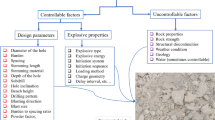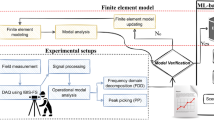Abstract
Ski-jump spillway (SJS) is one of the energy-dissipating structures, passing the flood through the dams. In these structures, the downstream bed is scoured due to the collision of the high energy jet. It is essential to obtain information on the scour-hole dimensions to enhance the safety of the dam and related structures. The machine learning and data mining methods are efficient in predicting hydraulic phenomena. In this study, the geometric properties of the scour-hole including the hole expansion (width), maximum depth of the scour and its distance from the end edge of the spillway were predicted using a model by combining the adaptive neuro-fuzzy inference system (ANFIS) and the particle swarm optimization (PSO) algorithm. The results showed that the developed ANFIS–PSO model obtained maximum scour depth with a precision of R2 = 0.94 and RMSE = 0.565, scour hole width with precision of R2 = 0.95 and RMSE = 1.153 and its distance from the end edge of the SJS with an accuracy of R2 = 0.96 and RMSE = 1.809. The evaluation and comparison of the simulation results indicated the superiority of the proposed model over other methods.











Similar content being viewed by others
References
Azamathulla HM, Ghani Aminuddin A (2011) ANFIS-based approach for predicting the scour depth at culvert outlets. J Pipeline Syst Eng Pract 2(1):35–40
Azamathulla HM, Deo MC, Deolalikar PB (2005) Neural networks for estimation of scour downstream of a ski-jump bucket. J Hydraul Eng 131(10):898–908
Azamathulla H, Ghani A, Zakaria N, Lai S, Chang C, Leow C, Abuhasan Z (2008a) Genetic programming to predict ski-jump bucket spill-way scour. J Hydrodyn 20(4):477–484
Azamathulla HM, Deo MC, Deolalikar PB (2008b) Alternative neural networks to estimate the scour below spillways. Adv Eng Softw 39(8):689–698
Azamathulla HM, Ghani AA, Zakaria NA (2009) ANFIS-based approach to predicting scour location of spillway. Proc Inst Civ Eng Water Manag 162(6):399–407
Azimi H, Bonakdari H, Ebtehaj I, Ashraf Talesh SH, Michelson DG, Jamali A (2017) Evolutionary Pareto optimization of an ANFIS network for modeling scour at pile groups in clear water condition. Fuzzy Sets Syst 319:50–69
Ebtehaj I, Sattar AMA, Bonakdari H, Zaji AH (2016) Prediction of scour depth around bridge piers using self-adaptive extreme learning machine. J Hydroinform 19(2):207–224
Ebtehaj I, Bonakdari H, Gharabaghi B (2019) Closure to “An integrated framework of extreme learning machines for predicting scour at pile groups in clear water condition” by: I. Ebtehaj, H. Bonakdari, F. Moradi, B. Gharabaghi, Z. Sheikh Khozani. Coast Eng 147:135–137
Farhoudi J, Hosseini SM, Sedghi-Asl M (2009) Application of neuro-fuzzy model to estimate the characteristics of local scour downstream of stilling basins. J Hydroinform 12(2):201–211
Goyal MK, Ojha CSP (2011) Estimation of scour downstream of a ski-jump bucket using support vector and M5 model tree. Water Resour Manag 25(9):2177–2195
Guven A, Gunal M (2008) Genetic programming approach for prediction of local scour downstream of hydraulic structures. J Irrig Drain Eng 134(2):241–249
Haghiabi A (2017) Estimation of scour downstream of a ski-jump bucket using the multivariate adaptive regression splines. Sci Iran 24(4):1789–1801
Haghiabi AH, Parsaie A, Ememgholizadeh S (2018a) Prediction of discharge coefficient of triangular labyrinth weirs using adaptive neuro fuzzy inference system. Alex Eng J 57(3):1773–1782
Haghiabi AH, Nasrolahi AH, Parsaie A (2018b) Water quality prediction using machine learning methods. Water Qual Res J 53(1):3–13
Heller V, Hager WH, Minor H-E (2005) Ski jump hydraulics. J Hydraul Eng 131(5):347–355
Heng S, Tingsanchali T, Suetsugi T (2013) Prediction formulas of maximum scour depth and impact location of a local scour hole below a chute spillway with a flip bucket. WIT Trans Ecol Environ 172:251–262
Homaei F, Najafzadeh M (2020) A reliability-based probabilistic evaluation of the wave-induced scour depth around marine structure piles. Ocean Eng 196:106818
Jang JR (1993) ANFIS: adaptive-network-based fuzzy inference system. IEEE Trans Syst Man Cybern 23(3):665–685
Kennedy J, Eberhart R (1995) Particle swarm optimization (PSO). In: Proceedings of IEEE international conference on neural networks, Perth, Australia, 1942–1948
Moradi F, Bonakdari H, Kisi O, Ebtehaj I, Shiri J, Gharabaghi B (2019) Abutment scour depth modeling using neuro-fuzzy-embedded techniques. Mar Georesour Geotechnol 37(2):190–200
Naderpour H, Rafiean AH, Fakharian P (2018) Compressive strength prediction of environmentally friendly concrete using artificial neural networks. J Build Eng 16:213–219
Naderpour H, Nagai K, Fakharian P, Haji M (2019) Innovative models for prediction of compressive strength of FRP-confined circular reinforced concrete columns using soft computing methods. Compos Struct 215:69–84
Najafzadeh M (2015a) Neuro-fuzzy GMDH based particle swarm optimization for prediction of scour depth at downstream of grade control structures. Eng Sci Technol Int J 18(1):42–51
Najafzadeh M (2015b) Neuro-fuzzy GMDH systems based evolutionary algorithms to predict scour pile groups in clear water conditions. Ocean Eng 99:85–94
Najafzadeh M, Barani GA (2011) Comparison of group method of data handling based genetic programming and back propagation systems to predict scour depth around bridge piers. Sci Iran 18(6):1207–1213
Najafzadeh M, Kargar Ali R (2019) Gene-expression programming, evolutionary polynomial regression, and model tree to evaluate local scour depth at culvert outlets. J Pipeline Syst Eng Pract 10(3):04019013
Najafzadeh M, Lim SY (2015) Application of improved neuro-fuzzy GMDH to predict scour depth at sluice gates. Earth Sci Inf 8(1):187–196
Najafzadeh M, Saberi-Movahed F (2019) GMDH-GEP to predict free span expansion rates below pipelines under waves. Mar Georesour Geotechnol 37(3):375–392
Najafzadeh M, Barani G-A, Hessami-Kermani M-R (2014) Group method of data handling to predict scour at downstream of a ski-jump bucket spillway. Earth Sci Inf 7(4):231–248
Najafzadeh M, Etemad-Shahidi A, Lim SY (2016) Scour prediction in long contractions using ANFIS and SVM. Ocean Eng 111:128–135
Noori R, Hooshyaripor F (2014) Effective prediction of scour downstream of ski-jump buckets using artificial neural networks. Water Resour 41(1):8–18
Parsaie A, Dehdar-Behbahani S, Haghiabi AH (2016) Numerical modeling of cavitation on spillway’s flip bucket. Front Struct Civ Eng 10(4):438–444
Parsaie A, Haghiabi AH, Saneie M, Torabi H (2017) Predication of discharge coefficient of cylindrical weir-gate using adaptive neuro fuzzy inference systems (ANFIS). Front Struct Civ Eng 11(1):111–122
Parsaie A, Azamathulla HM, Haghiabi AH (2018) Prediction of discharge coefficient of cylindrical weir–gate using GMDH-PSO. ISH J Hydraul Eng 24(2):116–123
Raikar RV, Wang C-Y, Shih H-P, Hong J-H (2016) Prediction of contraction scour using ANN and GA. Flow Meas Instrum 50:26–34
Rezazadeh Eidgahee D, Haddad A, Naderpour H (2019) Evaluation of shear strength parameters of granulated waste rubber using artificial neural networks and group method of data handling. Sci Iran 26(6):3233–3244
Rezazadeh Eidgahee D, Rafiean AH, Haddad A (2020) A novel formulation for the compressive strength of IBP-based geopolymer stabilized clayey soils using ANN and GMDH-NN approaches. Iran J Sci Technol Trans Civ Eng 44(1):219–229
Sharafi H, Ebtehaj I, Bonakdari H, Zaji AH (2016) Design of a support vector machine with different kernel functions to predict scour depth around bridge piers. Nat Hazards 84(3):2145–2162
Yuan S-F, Chu F-L (2007) Fault diagnostics based on particle swarm optimisation and support vector machines. Mech Syst Signal Process 21(4):1787–1798
Zadeh LA (1965) Fuzzy sets. Inf Control 8(3):338–353
Author information
Authors and Affiliations
Corresponding author
Rights and permissions
About this article
Cite this article
Nou, M.R.G., Zolghadr, M., Bajestan, M.S. et al. Application of ANFIS–PSO Hybrid Algorithm for Predicting the Dimensions of the Downstream Scour Hole of Ski-Jump Spillways. Iran J Sci Technol Trans Civ Eng 45, 1845–1859 (2021). https://doi.org/10.1007/s40996-020-00413-w
Received:
Accepted:
Published:
Issue Date:
DOI: https://doi.org/10.1007/s40996-020-00413-w




